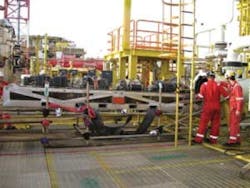Drilling supervisors at GDF Suez E&P Deutschland GMBH have used a visual road map to control drilling operations since March 2008.
The Leer Z5-5 is one of the tight gas wells recently drilled by GDF Suez E&P Deutschland GMBH in Lower Saxony, Germany (Fig. 1).
Fig. 1 shows one of the wells drilled. The drilling process assistant software includes a database that holds records of all area or rig specific drilling sequences, previous lessons learned, and lost-time accidents.
The program also allows for the transfer of all essential sections of the drilling program into a one-page visual roadmap for each standard drilling, casing-liner, and cement sequence.
Another feature of the software includes one-page visual roadmaps for all standard drilling sequences such as motor and measurement-while-drilling, window milling, underreaming, coring, completions, sidetrack, etc.
Also created are one-page visual roadmaps for all critical drilling sequences. These pages indicate how to avoid and react to stuck pipe, well control, mud loss, and other critical situations.
Each page combines all operational sequences, previous lessons learned and lost-time accidents. Fig. 2 shows a sample page.
The software includes a list of prechecks and preparations to be carried out for each sequence. This list confirms that required checks and preparations took place.
The software also helps drilling engineers plan drilling programs.
Implementation
The market conditions in 2008 had forced drilling contractors and service companies to carry out their services with many new employees.
To ensure that everyone was aware of the procedures to follow, GDF Suez E&P Deutschland implemented this software to improve communications among parties. The software allowed the drilling team to exchange, combine, and use all available experience and skills. The software did not replace the drilling program or procedures but acted as an on site process planner, communicator, and controller.
The software implementation included a review of all well data, lost time, and lost-time accidents for each drilling area, rig type, and service company.
The senior drilling supervisor reviewed the draft drilling process assistant software to make sure that it included his experiences and lessons learned while drilling previous wells in each area.
The company implemented the software during 1 year while drilling and completing a high-pressure-high-temperature horizontal well and several slim-hole and standard wells in Germany.
Measurable processes
The following lists some examples of measurable processes that the software is intended to help avoid and correct by having the drilling team check each reference page and check list before commencing the drilling and completion sequence.
During the implementation phase, there were no company or drilling contractor lost-time accidents.
Some of the lost-time incidents that the software helped to avoid during the implementation phase were:
- Stuck pipe situations by listing the immediate steps to take when problems arose
- Lost time by calling for in time checks of required drilling tools.
- A previous stuck-pipe incident by recommending a change to a heavy-weight drill pipe as the bottomhole assembly in an 81⁄2 in. hole section.
- A previous waiting time on wrong or missing parts by having a checklist of all wellhead, blowout preventer, and wear-bushing parts.
- Previous washouts and mud losses by recommending drilling the 171⁄2-in. hole section with minimum pump rate.
- Previous sidetracks by recommending casing check trips with bull nose pipe.
In the standard drilling practices section of the software, some of the practices called for to avoid previously encountered incidents were:
- Not laying down 5-in. drill pipe and picking up 31⁄2-in. drill pipe until landing of the 7-in. casing. This recommendation is in case the 7-in. casing could not be set and the 5-in. drill pipe was required for reaming or check trips.
- Rechecking factory make-up for all pretorqued connections to avoid losing tools in hole.
- Circulating bottoms up completely or circulating each liner joint to bottom in case of hole problems to avoid stuck pipe situations.
- Baker locking bull nose and underreamer nozzles to avoid fishing jobs for drilling tools.
- Not function-testing the motor with a polycrystalline-diamond-compact (PDC) bit inside casing to avoid casing and bit damage.
- Not running junk baskets through window because the basket will hang up and create a stuck-pipe situation.
- Not storing or transporting ditch magnets and measurement-while-drilling tools together to avoid MWD tool failures.
- Installing a 1 or 2-in. reducer valve in the cement head to reduce cement drop and suction problems.
- Using a dedicated cement-water mix tank to avoid contaminating cement water.
- Using proper pump start-up practices to avoid mud losses.
- Using standard checklist procedures to prevent the cement stinger stab-in sub OD from not sealing in the casing collar.
Acknowledgment
The authors gratefully acknowledge the support and assistance of Heinz Wendel and Joachim Wagener of GDF Suez.
The authors


